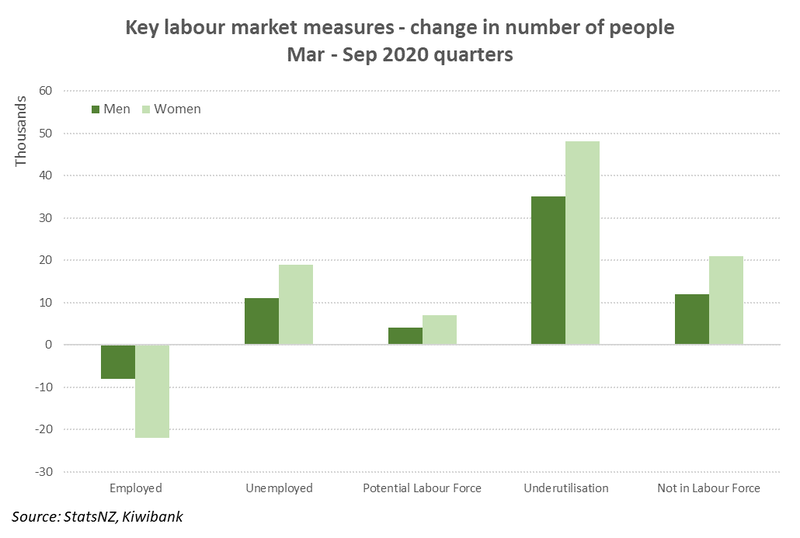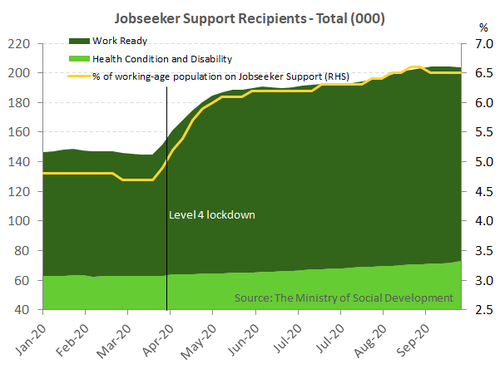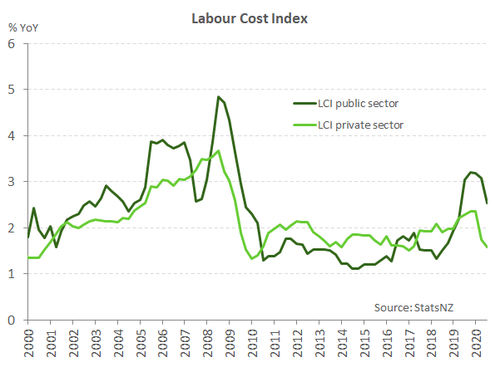
- We’ve just seen the largest spike in unemployment in a very long time. There were 37,000 people out of work in the quarter, eclipsing the next largest spike of 18k recorded during the Global Financial Crisis.
- Women are bearing the brunt of the burden. And what’s more worrying is the growing number of women leaving the workforce. The number of Māori women employed in tourism fell a whopping 20%.
- The unemployment rate spiked to 5.3%. The underutilisation rate lifted again, to 13.2%. Slack is building in the labour market. Wage growth eased to just 1.6%. The outlook is soft, given the slack.
- Policymakers will view the report for what it is, confirmation we’re in a recession. More stimulus is required.
We’ve just seen the largest spike in unemployment in a very long time. There were 37,000 people out of work in the quarter, eclipsing the next largest spike of 18k recorded during the Global Financial Crisis of 2008.
Women are bearing the brunt of the burden, as there are more women in the hardest hit tourism industries. And what’s more worrying is the growing number of women leaving the workforce. The number of Māori women employed in tourism fell a whopping 20%.
The spike in the unemployment rate to 5.3%, followed the ‘unbelievable’ decline to 4% last quarter. The print was in line with our forecast of 5.2%. The underutilisation rate lifted again, to 13.2%. Slack is building in the labour market, and wages are softening. Wage growth eased to 1.6% from 2.4% at the start of the year. The outlook is soft, given the slack developing in the labour market.
Policymakers will view the report for what it is, confirmation we’re in a recession. People have lost their jobs. And the unemployment rate is set to rise further. The lockdowns and border closures have had a profound impact on some, and a limited impact on many. And the fragility of the economy remains the number one concern for policymakers. More needs to be done to stimulate the economy in the recovery. Government led initiatives (fiscal policy) are the most effective and should focus more on SME business and job creation. Across the street, the RBNZ is expected to deliver a funding for lending programme (FLP) next week, to enable banks to lower lending rates further. The RBNZ is unlikely to stop there. We think that the RBNZ will follow through on their quest to go negative next year. See our video commentary here.
Damage from lockdown revealed
The damage from lockdown was revealed in today’s labour market report. The unemployment rate jumped 1.3%pts to 5.3% - the highest rate in almost four years. Interestingly, the number of people recorded as unemployed jumped by a record 37,000, over twice as much as the previous peak of 18,000 back during the GFC. The spike is essentially payback for a counterintuitive fall in the number unemployed – and the unemployment rate –in the June quarter. An inability of those unemployed to seek paid employment during lockdown masked the true damage. Employment fell 0.8%qoq to now recorded back-to-back falls. From the firms’ side, filled jobs in the QES also recorded a second consecutive fall. But was a more muted 0.4%qoq decline. Paid hours in contrast recovered some of the 3.5% fall of last quarter, rising 1.6%. But in a reflection of the sustained damage from lockdown, paid hours remain 0.7% down on the same period last year.
GDP is not the only economic data experiencing massive swings due to covid. Total hours worked naturally rebounded 9.4% in the third quarter, following the lockdown induced 10.2% plunge in June. The labour force participation rate also bounced back to above 70% but is likely to fall in the coming quarters. Net migration has slowed to a trickle, and work is often a motivating factor for migrant arrivals. There is also the discouraged worker effect to consider. When jobs are scarce, people may leave the labour market to retrain, or stay home to cover childcare for example. Interestingly, in today’s figures the estimate of the number of people not in the labour force dropped by 5,000. But this compared to the 38,000 jump in Q2. Some made jobless during lockdown decided to step away from the labour market for the time being. 
September quarter labour market figures might have been worse if not for the ongoing policy support from the likes of the wage subsidy. However, the wage subsidy (including extensions) is currently supporting very few jobs. MSD was projecting only 409 jobs supported last week. At its peak, the wage subsidy supported the equivalent of 1.7mn jobs. The Band-Aid has been removed. Job losses are likely to rise from here. Jobseeker’s benefit recipient numbers have steadily risen out of lockdown (see chart). While not directly comparable to official unemployment numbers due to different definitions, job seekers benefit numbers do indicate the direction for the unemployment rate is higher ahead.
70% of the drop in Kiwi employment were women
The female unemployment rate rose to 5.8% (+18,000 more women unemployed) and the underutilisation rate shot to 16.2%, up from 14.9% (+18,000 women in the quarter), The numbers for men were similar. But quarterly changes reveal only a snippet of the whole truth. Rather, changes between the March and September 2020 quarters reveal that while both men and women have been negatively impacted, women have been worse affected.
Nationally, the seasonally adjusted number of people in employment fell by 31,000 between the March and September quarters. 70% (22,000) of the drop in Kiwi employment since March were women. The initial June quarter drop was simply too deep. For the same reasons male employment was hardest hit in previous crises, women are especially vulnerable this time around. Because over 60% of sales workers and over 70% of hospitality workers are female.
The decline in female employment since March stemmed from job losses within the tourism industries, including accommodation, travel agencies, sightseeing operators, and cafes and restaurants. And StatsNZ’s latest tourism satellite accounts show that the blow to tourism has disproportionately affected Māori women. There were 4,000 fewer Māori women employed in tourism industries in the June quarter than a year ago - a whopping 20.5% drop. With closed borders and any future limitations on domestic travel, it wouldn’t be a stretch to see more job losses and a rising unemployment rate among women and therefore among Māori women too.
Looking ahead, it’s possible we see a rise in female part-time employment. Employers sought a flexible workforce during the recovery phase in the 90s. As our economic recovery from the Great Lockdown builds momentum, firms today may share the same preferences. Women currently make up around 70% of the part-time labour force. So, for the same reason that women in part-time employment were the first to be let go, these women may be the first to be hired. The problem with part-time employment however is that it is often low paid and unsecured. And this doesn’t bode well for the gender pay gap. The gap has narrowed over the past decades - from ~16% in 1998 to ~9.5% - as more women have moved into different fields (notably, law, medicine and commerce) and into higher positions. But with some women either moving into part-time employment or opting to take a pay-cut or dropping out of employment altogether, the pay gap may widen.
What’s most worrying from the labour market report is the growing number of women leaving the workforce. In the September quarter, the number of women not in the labour force (seasonally adjusted) rose by 1,000, while 6,000 men re-entered the force. The lockdown may have strengthened the connection between female employment and childcare. There are unfortunate implications on women’s economic status if the female potential labour force continues to grow.
Covid slows wage growth
 Wage growth lifted a touch in the September quarter. The private sector Labour Cost Index (LCI) expanded 0.4% in the quarter from the 0.2% gain eked out last quarter. Nevertheless, annual LCI wage growth is fading, now at 1.6% down from 2.4% recorded at the start of 2020. Public sector wage growth is also showing a similar trend. And wage growth will likely remain muted ahead, even as the minimum wage hits $20/hr next year. Remember inflation is falling, and more importantly inflation expectations remain well below the 2% middle of the RBNZ’s target range. In this environment it becomes harder for workers to argue for large pay rises.
Wage growth lifted a touch in the September quarter. The private sector Labour Cost Index (LCI) expanded 0.4% in the quarter from the 0.2% gain eked out last quarter. Nevertheless, annual LCI wage growth is fading, now at 1.6% down from 2.4% recorded at the start of 2020. Public sector wage growth is also showing a similar trend. And wage growth will likely remain muted ahead, even as the minimum wage hits $20/hr next year. Remember inflation is falling, and more importantly inflation expectations remain well below the 2% middle of the RBNZ’s target range. In this environment it becomes harder for workers to argue for large pay rises.

